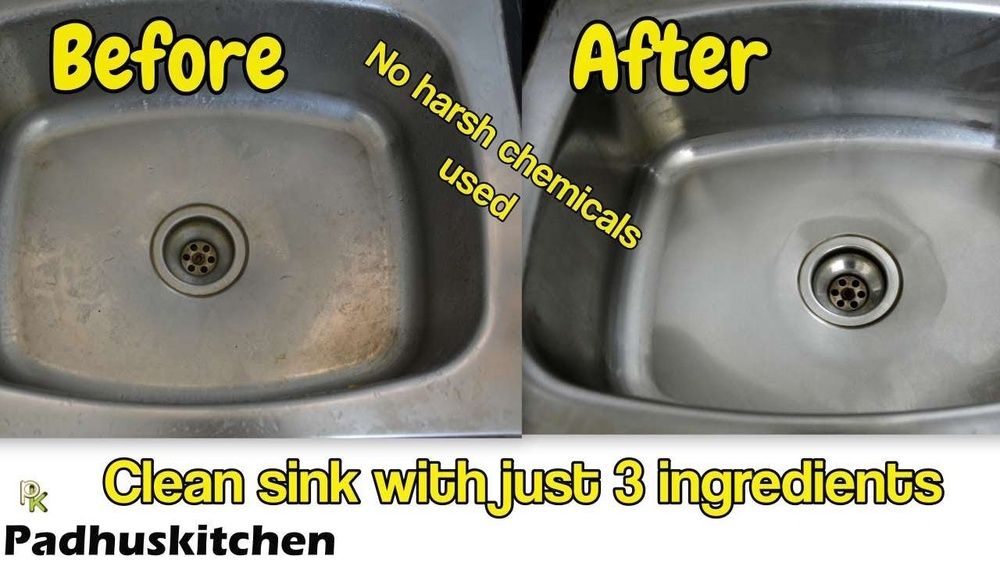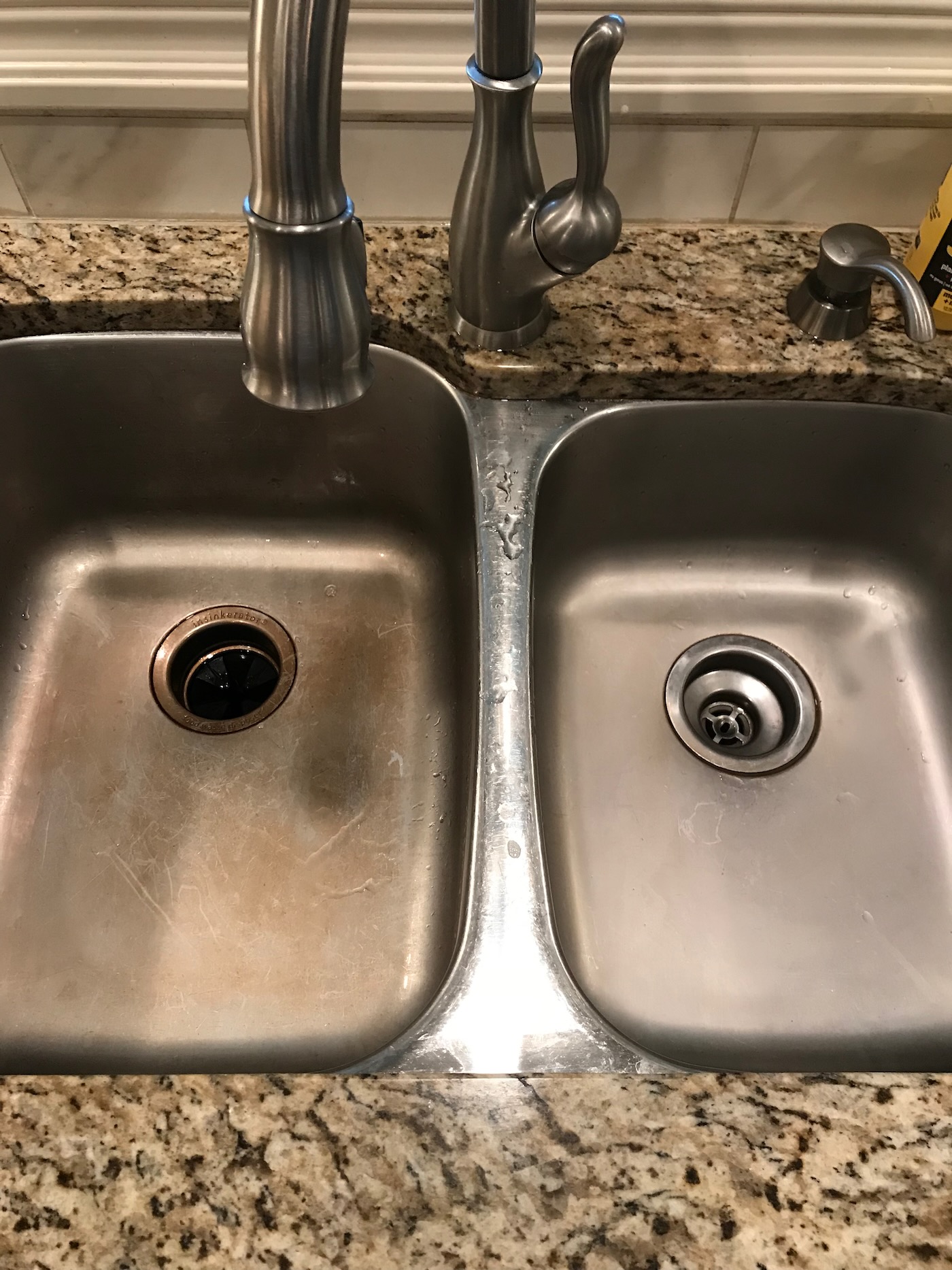
Your stainless steel sink is one of the busiest spots in your kitchen. It handles everything from washing dishes to prepping meals, and over time, it can start to look dull or stained.
But cleaning it doesn’t have to be a chore. What if you could make your sink sparkle with just a few simple steps? You’ll discover easy, effective ways to clean your stainless steel sink so it stays shiny and fresh.
Keep reading, and you’ll learn tips that save you time and effort while making your kitchen look its best.

Gather Cleaning Supplies
Gathering cleaning supplies is the first step to clean a stainless steel sink well. Having the right tools and products makes the job easier and faster. It also helps protect the sink’s surface from scratches and stains. Prepare everything before you start for smooth cleaning.
Essential Tools
Start with a soft sponge or cloth to avoid scratching the sink. A microfiber cloth works best for wiping and polishing. Use a small brush or old toothbrush for tight corners and around the drain. A rubber glove protects your hands from harsh cleaners. A spray bottle helps apply cleaning solutions evenly. Have a bucket ready to rinse or soak parts if needed.
Recommended Cleaning Products
Choose mild dish soap for daily cleaning. It removes grease and light dirt without harm. Baking soda is great for scrubbing tough spots gently. White vinegar helps remove water spots and mineral buildup. Avoid bleach or abrasive powders that can damage the finish. Use a stainless steel cleaner for extra shine on special occasions. Test any new product on a small area first.
Remove Debris And Rinse
Cleaning a stainless steel sink starts with removing all debris and rinsing it properly. This step clears dirt and food particles that can cause stains or odors. It also prepares the sink for a deeper clean. Taking time here makes the next cleaning steps easier and more effective.
Clear The Sink
Start by removing any leftover food, crumbs, or debris from the sink. Use your hands or a soft brush to gather bits stuck in the drain or corners. Dispose of the debris in the trash. Clearing the sink stops buildup and keeps the surface smooth.
Rinse With Warm Water
Next, rinse the sink with warm water to wash away loose dirt and soap residue. Warm water helps dissolve grease and makes the sink shine. Use your hands or a soft cloth to spread the water evenly. This simple rinse refreshes the surface and removes grime before scrubbing.
Apply Cleaning Solution
Applying a cleaning solution is a key step to keep your stainless steel sink shiny and clean. The right cleaner helps remove stains, grime, and water spots. It also protects the surface from damage. Choose a solution that suits your needs and is safe for stainless steel.
Use Mild Detergent
Mild detergent is gentle yet effective for cleaning stainless steel sinks. Mix a small amount of dish soap with warm water. Use a soft cloth or sponge to apply this mix over the sink. Rub gently to avoid scratches. Rinse with clean water and dry with a soft towel. This method removes everyday dirt and grease easily.
Natural Alternatives
Natural alternatives work well to clean and brighten your sink. Baking soda and vinegar are popular choices. Sprinkle baking soda on the sink surface. Pour some vinegar over it to create a fizzing action. Let it sit for a few minutes. Scrub softly with a sponge, then rinse with water. Lemon juice can also help remove stains and add shine. These natural options are safe and eco-friendly.

Scrub The Sink Surface
Scrubbing the sink surface is a key step to keep your stainless steel sink clean and shiny. Dirt and stains can stick to the surface, so proper scrubbing helps remove them effectively. This part of cleaning takes a little effort but gives great results. Use the right tools and methods to protect the sink while cleaning.
Gentle scrubbing removes grime without scratching the steel. Focus on every part of the sink, including corners and edges. This ensures the sink looks fresh and new.
Use A Soft Sponge
Choose a soft sponge for scrubbing. Hard brushes or steel wool can scratch the surface. A soft sponge cleans well without damage. Wet the sponge with warm water and apply a small amount of mild dish soap. Rub the sink in circular motions. This helps lift dirt and soap scum easily.
Rinse the sponge often to avoid spreading dirt back on the sink. Use gentle pressure to protect the sink’s finish. Soft sponges keep your sink safe during cleaning.
Focus On Stubborn Spots
Some stains or spots may not come off with regular scrubbing. For these areas, try a paste of baking soda and water. Apply it to the stain and let it sit for a few minutes. Then scrub gently with the soft sponge.
For tough spots, use a toothbrush to reach tight corners. Be patient and avoid harsh scrubbing. This method cleans stubborn stains without harming the steel.
Rinse And Dry Thoroughly
After cleaning your stainless steel sink, rinsing and drying it thoroughly is very important. This step removes any leftover cleaning products and prevents damage. Water and soap left on the surface can leave marks or cause stains.
Rinsing with clean water helps clear away dirt and cleaning agents. Drying the sink right after rinsing keeps it shiny and clean for longer. A dry sink looks fresh and well cared for.
Remove Cleaning Residue
Use warm water to rinse away soap and cleaner from every corner. Pay close attention to edges and corners where residue hides. A clean cloth or sponge works well to wipe off leftover cleaner. This stops buildup that can dull the sink’s shine.
Prevent Water Spots
Water spots form when water dries on the sink’s surface. Wipe the sink dry with a soft cloth or towel after rinsing. Drying quickly stops spots from forming. Use a microfiber cloth for the best results. Your sink will stay smooth and bright longer.
Polish For Extra Shine
Polishing a stainless steel sink gives it a bright, clean look. It removes dullness and small scratches. Polishing also helps protect the sink from future stains. A shiny sink makes your kitchen feel fresh and neat. Use simple methods and products for the best shine.
Use Olive Oil Or Specialized Polish
Olive oil works well for a natural shine. Put a few drops on a soft cloth. Rub the oil gently on the sink surface. It adds shine and hides small marks. You can also buy a polish made for stainless steel. These polishes clean and protect the metal. Follow the product instructions for the best results.
Buffing Techniques
Buffing helps spread the polish evenly. Use a soft, dry cloth for buffing. Move the cloth in small circles. This action makes the sink gleam without streaks. Avoid harsh scrubbing to prevent scratches. Buff until the sink looks bright and smooth. The right buffing brings out the best shine.
Maintain Regular Cleanliness
Maintaining regular cleanliness keeps your stainless steel sink shiny and lasting longer. Dirt and stains build up fast. Cleaning often stops tough grime and water spots. A simple routine saves time and effort over time.
Daily Care Tips
Rinse the sink after every use. Use a soft cloth to wipe dry. This stops water spots and mineral marks. Clean with mild soap and warm water daily. Avoid harsh chemicals that damage the steel. Use a gentle sponge or cloth only. Drying the sink after washing keeps it bright.
Avoiding Common Damages
Do not use steel wool or abrasive pads. They scratch the surface and dull the shine. Avoid bleach or strong acids that harm the steel. Never leave metal cans or wet sponges in the sink. These cause rust stains or marks. Use a sink grid to protect the bottom. Always clean spills quickly to avoid stains.

Frequently Asked Questions
How Do You Remove Stains From A Stainless Steel Sink?
Use a baking soda paste and gently scrub with a soft sponge. Rinse thoroughly with warm water and dry with a microfiber cloth. Avoid abrasive cleaners to prevent scratches.
What Household Items Clean Stainless Steel Sinks Effectively?
Baking soda, white vinegar, and lemon juice are great natural cleaners. They remove grime and restore shine without harsh chemicals. Always rinse well after cleaning.
Can Stainless Steel Sinks Be Cleaned With Bleach?
Bleach can damage the sink’s finish and cause discoloration. It’s best to avoid bleach and use mild detergents or natural cleaners instead.
How Often Should You Clean A Stainless Steel Sink?
Clean your sink daily to prevent buildup and water spots. A weekly deep clean keeps it shiny and hygienic. Quick daily care extends the sink’s lifespan.
Conclusion
Cleaning a stainless steel sink is simple with the right steps. Use gentle cleaners and soft cloths to avoid scratches. Regular cleaning keeps your sink shiny and fresh. Avoid harsh chemicals to protect the metal surface. Rinse and dry the sink after each use to prevent water spots.
Small daily efforts make a big difference. Keep your kitchen looking neat and welcoming. A clean sink adds to your home’s overall hygiene. Try these tips and enjoy a sparkling sink every day.





